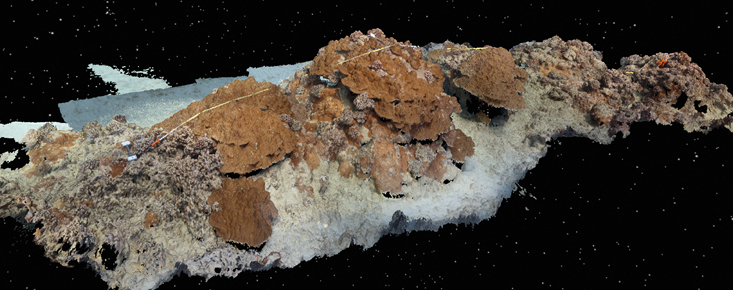-
Home
-
Data & Publications
-
Regional Portals
- About Regional Portals
- Florida
- Navassa Island
- Puerto Rico
- Flower Garden Banks
- U.S. Virgin Islands
- American Samoa
- Commonwealth of the Northern Mariana Islands
- Federated States of Micronesia
- Guam
- Main Hawaiian Islands
- Republic of the Marshall Islands
- Northwestern Hawaiian Islands
- Republic of Palau
- Pacific Remote Island Areas
-
CRCP Activities
- Glossary
New Study Compares Coral Reef Monitoring Data Collected In-Water and 3D Imaging Data

Coral reef monitoring helps researchers and managers understand the health and status of ecosystems to make science-based conservation decisions. As threats to coral reefs-ocean warming, ocean acidification, fishing pressure, and local impacts like pollution-increase in severity and frequency, scientists are looking for ways to increase monitoring scale and efficiency. Traditionally, coral monitoring is completed using in-water surveys, where diver teams collect data underwater in real-time. While this method is tried-and-true, it is hard to scale-up because divers are limited by the amount of time they can safely stay underwater. Scientists are now exploring the use of 3D technology such as photogrammetry, also called Structure-from-Motion, to collect imagery that can be analyzed later and significantly reduce dive time underwater. Collecting 3D imagery also has the added benefit of creating a permanent record of a reef site to look at in the future. While Structure-from-Motion imagery can potentially save time in the water, it involves much more time to extract data. The big question is whether data collected in the water in real-time is comparable to data extracted from 3D imagery for the same reef area.
In a new study, National Coral Reef Monitoring Program scientists at the Pacific Islands Fisheries Science Center led by Dr. Courtney Couch compared data from in-water coral surveys to data generated from Structure-from-Motion imagery for the first time to test the differences between the methods for the same reef areas. Couch and her team found that the majority of the tested metrics did not vary between methods. However, there were some exceptions for metrics including coral partial mortality, coral bleaching prevalence, and the juvenile density of a specific coral genera. Overall, this study suggests that Structure-from-Motion imagery may revolutionize the way we monitor coral reefs in the future.
Read the full study here: Comparing Coral Colony Surveys From In-Water Observations and Structure-From-Motion Imagery Shows Low Methodological Bias.


